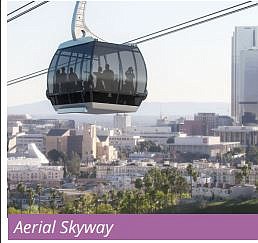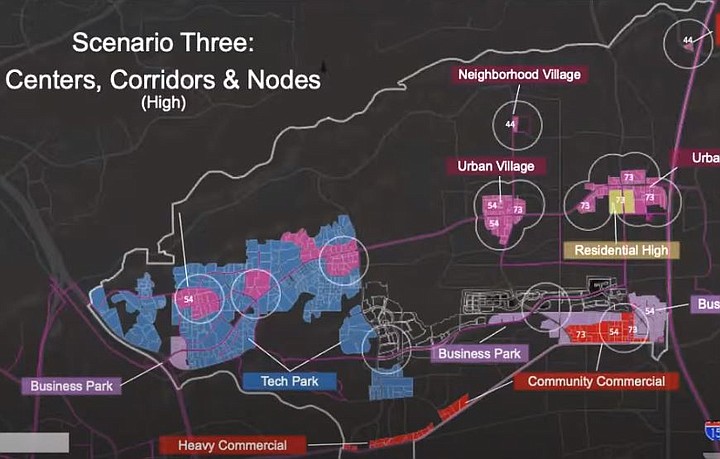 Facebook
Facebook
 X
X
 Instagram
Instagram
 TikTok
TikTok
 Youtube
Youtube

Unlike neighborhoods where new housing is seen as a scourge, residents of Mira Mesa are welcoming density. And the possibility of actually walking to work.
Surveys for the community plan update found that slightly more residents support the approach. So planners will now begin to focus on the most housing intense options for the update, which was the topic of a workshop last week.
For each of three land-use scenarios, locals clamored for ways to get around without a car. One goal is to create "15 minute neighborhoods," the time it takes to walk to work or a shopping center. Commuting by aerial skyway is even part of the proposal.
"San Diego has such a big housing shortage," said resident Sonali Kumar, who has struggled with the lack of options. "I support scenario three because it's the more housing dense one, creating more housing near employment centers."
Mira Mesa, located in north central San Diego, has far more jobs than homes or sidewalks. And that has led to an unsurprising disconnect.
In 2018, over 80,000 people commuted into Mira Mesa, while over 32,000 residents commuted out. Only about 7,900 people both live and work in Mira Mesa.
A typical household in Mira Mesa spends over $10,000 annually in transportation costs.

So, planners are looking to intensify residential and employment land uses within transit priority areas.
Scenario three would provide the greatest boost to the number of residents and workers within a 15-minute walk to an "activity hub." It would also boost potential new housing in transit priority areas, nearly twice that of the least intensive option. Not everyone likes the idea.
"Many of my neighbors are concerned about the possibility of increased congestion" due to upzoning, said Aaron Barral. But greater density is actually the solution to the traffic problems, he added.
"When you provide enough housing choices close to where people work and shop, driving becomes optional."
Planners centered on the two main employment centers where 85 percent of jobs are clustered: Sorrento Mesa, which is mostly industrial parks, and Miramar, with its light industrial uses such as warehouses and breweries.
According to senior planner, Alex Frost, after survey results were in, SANDAG proposed a higher density for Sorrento Mesa to reflect their latest ideas for high speed commuter rail.

Other focus areas are Mira Mesa Gateway off I-15, where residents preferred a business park designation, and Mira Mesa Town Center, where the preference was for community village (54 dwelling units per acre) and urban village (73 dwelling units per acre) designations.
"Most of the results were for change" instead of keeping the existing land use, Frost said of the survey. People wanted higher density and more mixed use village settings for a lot of the shopping centers and employment areas.
"I think a lot of the younger participants wanted to see more change."
But Craig Jackson, a member of the Mira Mesa Community Planning Group, spoke for change - for seniors. "Transportation along the corridor that is Sorrento Valley Blvd. and Calle Cristobal, a collection of single-family homes, has been mostly ignored," he said.
"Transportation from this area to the hubs will be important, particularly for seniors."
Two large projects in Carroll Canyon had the support of the planning group, in part for adding a lot of new parkland: 3 Roots, an 1,800-unit project with 10 percent of units deed restricted for low income; and Stonecreek, with 4,450 units.
In contrast, Frost said, the community plan update proposes to add 12,023 housing units with no new parkland.
Will there be any incentives for building housing, asked commissioner Doug Austin?
"There are folks out there trying to get some of the larger corporations to help subsidize middle-income housing." So if Qualcomm or anyone wants to build housing, are there incentives or benefits that would allow more density?
Frost said they have been in "long discussion" with Qualcomm and other large employers, like Alexander Real Estate and other life science developers, but all they can provide in the update is the zoning shift.
"I think the biggest incentive is to first allow for some kind of residential mixed-use within this employment setting."


Unlike neighborhoods where new housing is seen as a scourge, residents of Mira Mesa are welcoming density. And the possibility of actually walking to work.
Surveys for the community plan update found that slightly more residents support the approach. So planners will now begin to focus on the most housing intense options for the update, which was the topic of a workshop last week.
For each of three land-use scenarios, locals clamored for ways to get around without a car. One goal is to create "15 minute neighborhoods," the time it takes to walk to work or a shopping center. Commuting by aerial skyway is even part of the proposal.
"San Diego has such a big housing shortage," said resident Sonali Kumar, who has struggled with the lack of options. "I support scenario three because it's the more housing dense one, creating more housing near employment centers."
Mira Mesa, located in north central San Diego, has far more jobs than homes or sidewalks. And that has led to an unsurprising disconnect.
In 2018, over 80,000 people commuted into Mira Mesa, while over 32,000 residents commuted out. Only about 7,900 people both live and work in Mira Mesa.
A typical household in Mira Mesa spends over $10,000 annually in transportation costs.

So, planners are looking to intensify residential and employment land uses within transit priority areas.
Scenario three would provide the greatest boost to the number of residents and workers within a 15-minute walk to an "activity hub." It would also boost potential new housing in transit priority areas, nearly twice that of the least intensive option. Not everyone likes the idea.
"Many of my neighbors are concerned about the possibility of increased congestion" due to upzoning, said Aaron Barral. But greater density is actually the solution to the traffic problems, he added.
"When you provide enough housing choices close to where people work and shop, driving becomes optional."
Planners centered on the two main employment centers where 85 percent of jobs are clustered: Sorrento Mesa, which is mostly industrial parks, and Miramar, with its light industrial uses such as warehouses and breweries.
According to senior planner, Alex Frost, after survey results were in, SANDAG proposed a higher density for Sorrento Mesa to reflect their latest ideas for high speed commuter rail.

Other focus areas are Mira Mesa Gateway off I-15, where residents preferred a business park designation, and Mira Mesa Town Center, where the preference was for community village (54 dwelling units per acre) and urban village (73 dwelling units per acre) designations.
"Most of the results were for change" instead of keeping the existing land use, Frost said of the survey. People wanted higher density and more mixed use village settings for a lot of the shopping centers and employment areas.
"I think a lot of the younger participants wanted to see more change."
But Craig Jackson, a member of the Mira Mesa Community Planning Group, spoke for change - for seniors. "Transportation along the corridor that is Sorrento Valley Blvd. and Calle Cristobal, a collection of single-family homes, has been mostly ignored," he said.
"Transportation from this area to the hubs will be important, particularly for seniors."
Two large projects in Carroll Canyon had the support of the planning group, in part for adding a lot of new parkland: 3 Roots, an 1,800-unit project with 10 percent of units deed restricted for low income; and Stonecreek, with 4,450 units.
In contrast, Frost said, the community plan update proposes to add 12,023 housing units with no new parkland.
Will there be any incentives for building housing, asked commissioner Doug Austin?
"There are folks out there trying to get some of the larger corporations to help subsidize middle-income housing." So if Qualcomm or anyone wants to build housing, are there incentives or benefits that would allow more density?
Frost said they have been in "long discussion" with Qualcomm and other large employers, like Alexander Real Estate and other life science developers, but all they can provide in the update is the zoning shift.
"I think the biggest incentive is to first allow for some kind of residential mixed-use within this employment setting."
Comments